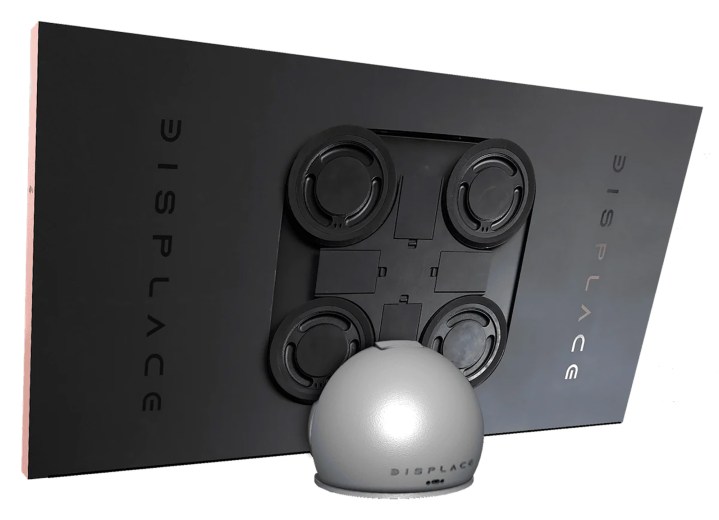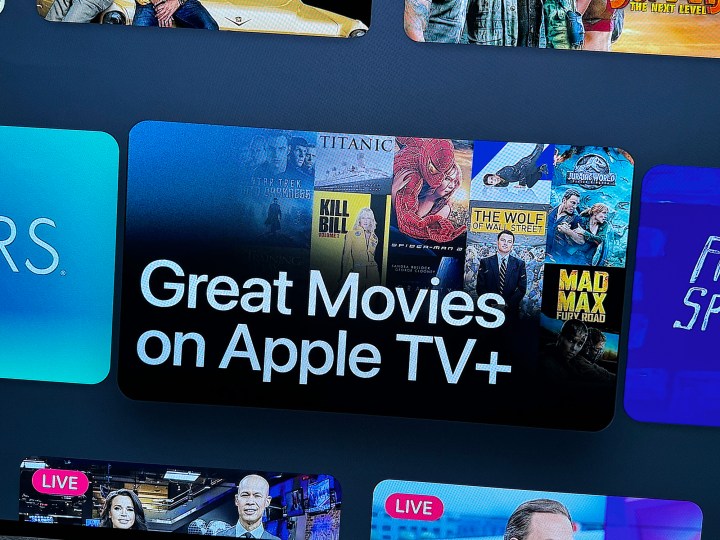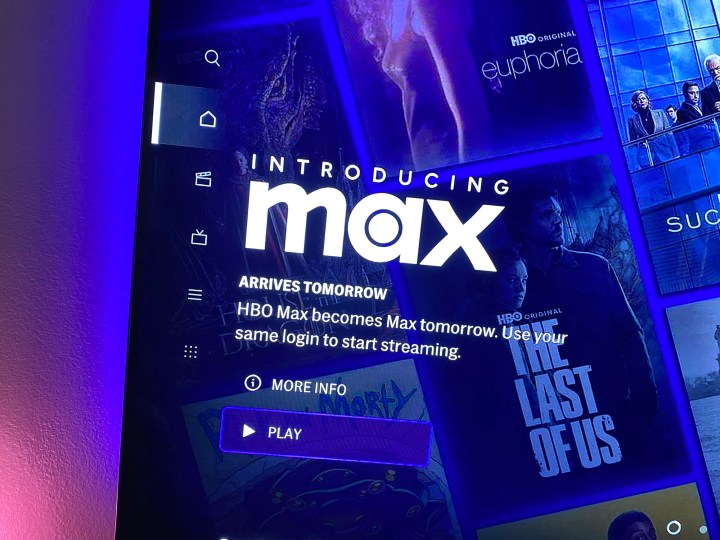
Anyone who says it’s been a slow news week obviously has never seen a slow news week. We’ve actually had plenty of TV and audio news to catch up on, in addition to everything else we’ve already covered over the past seven days.
Let’s take a look at a few of our favorites that threatened to slip through the cracks, only to be reeled back in here.
Vacuum-suction TVs seem … weird?
Mobile World Congress (MWC) in Barcelona is one hell of a trade show. And as the name implies, it’s mostly phones. But not only phones.
Startup Displace made a splash at CES 2023 with a $3,000 55-inch OLED TV that sticks to, well, most anything thanks to a weirdly ingenious vacuum-suction setup. The whole thing is powered by removable batteries, so it’s truly wireless in that regard. And now there’s the smaller, 27-inch Displace Mini. Fridge didn’t come with a display built in? This takes care of that. Or you can snap multiple Minis together to make a bigger TV.

TechCrunch caught up with the Displace CEO at MWC this week and reported that the Mini will have some previously unannounced features when it ships, including an “AI-powered shopping engine,” because of course it will. (Displace already had announced an NFC reader for making payments and thermal camera.)
The first-run going price is $2,499. But at least it also comes with a stand. Or, rather, it did — it’s currently sold out.
Rick Rubin uses what?
Clips of legendary music producer Rick Rubin on Andrew Huberman’s podcast are making the rounds. Apparently, Bluetooth headphones are scary and bad and can give you warts, or something. Or they’re just too hot.
“There are ones with air tubes that I use, depending on what’s going on,” Rubin said. “And there’s no electrical … near your head. It’s just an air tube where … actual sound is traveling to your ears.”
I’m not going to begrudge anyone’s reasons for using one kind of tech over another. (I will reserve the right to make fun of it internally, at least.) But folks probably need to stop sharing Amazon affiliate links to $50 “air tube headphones” as if that’s what Rubin’s using when he’s producing music.
Because it’s not. And he’s probably not wearing them even at home most of the time.
Apple TV+ starts licensing movies
If you subscribe to Apple TV+, you might have noticed that there are a few dozen movies (50, according to Variety) that Apple has licensed to stream on the service. It’s not the first time Apple TV+ has made non-exclusive content available alongside the likes of Severance, Ted Lasso, and the newer (and excellent) Masters of the Air and Constellation, but this is definitely the biggest tranche of non-Apple content to be featured.

That in and of itself is interesting. But it’s also pretty easy to miss. If you have all your other streaming services tied into the Apple TV app (the ones that play nice with it, anyway — remember that Netflix does not), the movies like The Wolf of Wall Street, Gravity, Mad Max Fury Road, and Mean Girls (to name but a few) may be lumped in with everything else.
Apple has put them all in a “Great Movies on Apple TV+” section, which helps a little, provided you scroll down enough to find it in the first place. But then you’re presented with a “Top movies” list, and four of the first five entries are recent flicks on Apple TV+, including Napoleon, Killers of the Flower Moon, The Family Plan, and Greyhound. Saving Private Ryan gets the No. 3 entry, though.
Still, this is a good thing. Apple TV+ is an excellent option and continues to put out new series and movies worth watching. That it’s starting to include older movies only gets you that much more for your monthly subscription.
Of course, the question this raises is how much longer will it be before Apple raises that monthly price in the name of giving you more content — even if it’s something you’ve already watched a million times already.
A new DVR standard for ATSC 3.0, for what that’s worth
A new DVR spec has been worked out for ATSC 3.0 devices, otherwise known as NextGen TV, that (among other things) lets you get over-the-air broadcasts at up to 4K resolution.
Her are the details from Ron Wheeler, manager director of A3SA, which is the organization behind the standards: “For the past year, we’ve been working in consultation with several electronics companies who are developing devices designed to add new features for NextGen TV viewers, from simple DVRs to more advanced home networking systems. After considering the various home scenarios, A3SA is pleased to release detailed specifications that will guide companies and soon provide consumers with a wealth of new options for digital video recording and more.”
NextGen TV — which remains far from a household name — has suffered from some serious chicken-or-egg syndrome. First, the broadcast source has to have updated to it. Then you have to have an ATSC 3.0 tuner in whatever device you’re using. Some TV manufacturers have switched to it, and some haven’t.
At least you don’t need a new antenna, I guess. But it remains to be seen whether a new DVR standard could serve as a linchpin to new devices.
Tablo TV — which is the networked streaming box we recommend if you want to watch OTA broadcasts on more than one device in your home — opted not to use an ATSC 3.0 tuner in its latest products. (It did support ATSC 3.0 in a previous generation, with caveats.) But it says the new NextGen TV DVR standards are a step in the right direction.

“We’ve been working closely with the A3SA in developing the new specs for ATSC 3.0 DVRs,” Tablo spokeswoman Laura Slater told me in an email. “While there is still some work to do in terms of DRM support for iOS devices, it certainly provides a much clearer path forward on the content protection front for a Tablo that could support NextGen TV.”
Slater said support for the AC4 audio codec remains a bigger sticking point. “Until more streaming and mobile devices offer support for that codec, DVR manufacturers will not be able to provide the whole-home viewing experience consumers enjoy for ATSC 1.0 broadcasts today,” she wrote.
Over-the-air television remains relevant in 2024. It’s a relatively low-cost way to get your local broadcast channels, and a one-time cost, at that. And that’s worth checking out as subscription prices continue to mount. But NextGen TV remains a mess, and not exactly a must-have selling point.
Max goes live in Latin America and the Caribbean
When Warner Bros. Discovery announced its fourth-quarter earnings, CEO David Zaslav said that “our top priority this year was to get this company on solid footing and on a pathway to growth, and we’ve done that.”
That pathway to growth includes expansion. And on February 27, Max went live in Latin America and the Caribbean.

“Max is now a reality in Latin America, and we are so excited to introduce it to audiences in the region with several plan options so that they can select the one that best fits their needs,” Juan Solá, streaming lead at Warner Bros. Discovery Latin America, said in a press release. “Max brings together the strengths of our brands with an enhanced streaming experience for an unmatched range of choice.”
Zaslav put the importance of expansion in context in the earnings call. “Keep in mind, we are only available in less than half the addressable households and markets as compared to our larger peers,” he said. “So,we still have a huge opportunity for growth and globalization over the next two years, including many critical markets around the globe.”
Up next for Max: Expansion in Europe, the Middle East, and Africa (referred to as EMEA), with France and Belgium going live for the Paris Olympics this summer.
More on Max
Other odds and ends …
- The home screen on your Google TV may look a little different soon, following an update first announced in late 2023.
- Paramount+ is now at 67.5 million paid subscribers worldwide, up 11.6 million from the fourth quarter of 2022.
- Fubo is now at 1.618 million paid subscribers for the fourth quarter of 2023, up 12% year over year. It’s three-fourths the subs that Sling TV has, and a quarter as many as Hulu With Live TV. (YouTube TV still leads with more than 8 million.)
- Amazon Fire TV now has a new virtual keyboard and remote. And you’ll see a QR code along with it — scan it and you’ll be able to type on your phone. It’s not quite as seamless as what you get with Apple TV and an iPhone or iPad, but it’s really not bad at all.
- Sonos’ CEO and CFO are scheduled to hit the Morgan Stanley Technology, Media & Telecom Conference on March 4. That could get interesting given the reports that a major release scheduled for the middle of the year may have been delayed.
- So far, so good for the start of the 2024 MLS season, and MLS Season Pass on Apple TV. I’m a soccer guy, and it’s still a big deal that this is available, and affordable.
Editors’ Recommendations

